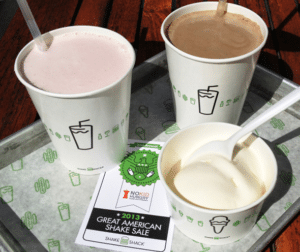 1. PINUPS
1. PINUPS
Go ahead, laugh, but these programs raise a bundle. You buy these paper icons (aka mobiles, scannables, paper plaques, etc.) at the register for a buck or two, sign your name to the pinup and the business displays it in the store. Who should we use as an example? St. Jude Children’s Research Hospital and Ann Taylor raised $4 million last fall. MDA and Lowe’s Home Stores raised $8.8 million with shamrocks this spring. Even small programs can raise a lot of loot. Shake Shack with just ten locations raised $135,000 in 2012 for No Kid Hungry. Their goal for this year is $150,000.
2. REGISTER PROGRAMS
This checkout program is similar to pinups but there is no ask from the cashier and no pinup. Instead participation is requested within the transaction process or on signage, for example. Still, these programs are efficient and lucrative. In the aftermath of the Boston Marathon bombing, businesses set up register programs to raise money for the victims. Two companies, Dunkin Donuts and CVS Pharmacy, raised over a million dollars in just a couple of weeks.
3. PERCENTAGE OF SALES
 These programs can range from a product that donates a portion or percentage from each sale to a donate profits day for everything in the store. Whole Foods is famous for its Community Giving Days that donate five percent of the net sales for the day to a local nonprofit. Of course, we see lots of POS products and services in October during Breast Cancer Awareness Month – although I don’t approve of all these items.
These programs can range from a product that donates a portion or percentage from each sale to a donate profits day for everything in the store. Whole Foods is famous for its Community Giving Days that donate five percent of the net sales for the day to a local nonprofit. Of course, we see lots of POS products and services in October during Breast Cancer Awareness Month – although I don’t approve of all these items.
My favorite POS for May comes from Raleigh Bicycles. I loved riding my Raleigh when I was kid! In celebration of National Bike Month and Military Appreciation Month, Raleigh Bicycles is giving back to our nations service men and women. During the promotional period ending May 27th, Raleigh will donated $50 to Ride to Recovery to help rehabilitate wounded veterans.
4. COLLECTION DRIVES
 Not every nonprofit is solely focused on cash. Inkind items can be just as valuable to them. And businesses are becoming a great place to access the items nonprofits need. Some companies will even offer a coupon or incentive for consumers that donate items. My favorite program in May comes from the National Association of Letter Carriers. On May 11, letter carriers collected food donations along their postal routes – read all about the Stamp Out Hunger campaign here. After thinking about how many of my wife’s shopping catalogs my postman has to carry this is labor intensive effort! And postal carriers have been doing it for 21 years!
Not every nonprofit is solely focused on cash. Inkind items can be just as valuable to them. And businesses are becoming a great place to access the items nonprofits need. Some companies will even offer a coupon or incentive for consumers that donate items. My favorite program in May comes from the National Association of Letter Carriers. On May 11, letter carriers collected food donations along their postal routes – read all about the Stamp Out Hunger campaign here. After thinking about how many of my wife’s shopping catalogs my postman has to carry this is labor intensive effort! And postal carriers have been doing it for 21 years!
5. CAUSE PRODUCTS
 I’m reaching here a bit with this final one, but I do believe cause products will be a big part of the future of cause marketing. Consumers want real connections. And making a product for a cause says something about the relationship between a company and cause. To demonstrate their commitment to the victims of the Boston Marathon bombing, Boston Beer Company has filed a trademark for “Boston Strong” 26.2 Brew in the beer category. The trademark will allow for Boston Beers annual marathon beer, 26.2 Brew, to be re-named to provide ongoing support to the victims.
I’m reaching here a bit with this final one, but I do believe cause products will be a big part of the future of cause marketing. Consumers want real connections. And making a product for a cause says something about the relationship between a company and cause. To demonstrate their commitment to the victims of the Boston Marathon bombing, Boston Beer Company has filed a trademark for “Boston Strong” 26.2 Brew in the beer category. The trademark will allow for Boston Beers annual marathon beer, 26.2 Brew, to be re-named to provide ongoing support to the victims.
An interesting and growing sub category of cause products are signature cause products. These iconic – sometimes kitschy – products capture the spirit of the brands we love! A good example is the hamburger and onion scented candle White Castle sells to fans to support Autism Speaks.
Which cause marketing campaigns are you raking in the dollars with? Sound off in the comments below!
